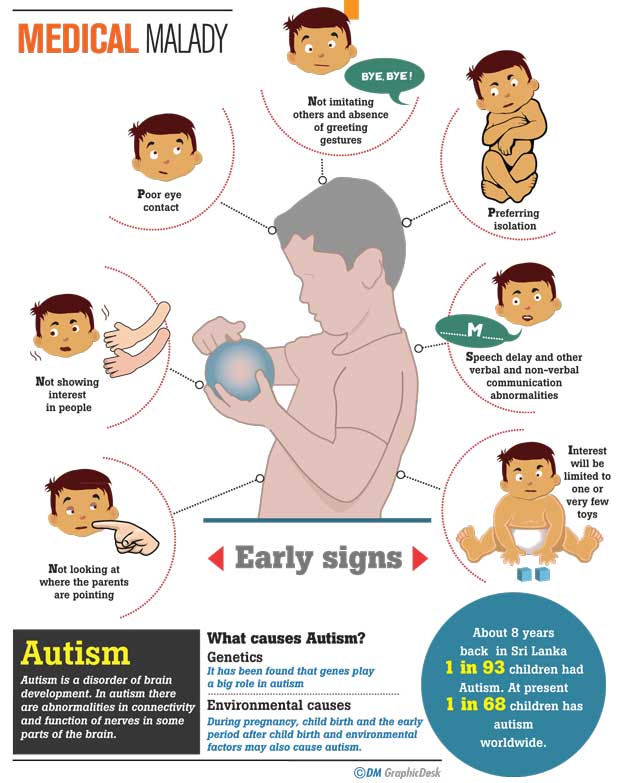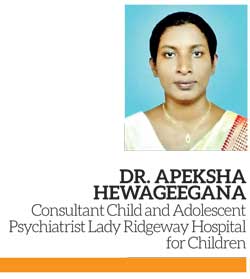Reply To:
Name - Reply Comment

 April 2nd is named as World Autism Awareness Day with the view of spreading awareness and sensitizing people about the brain disorder. An international campaign ‘Light It Up Blue’ is observed on this day. However, knowledge of Autism in Sri Lankans is still limited. Here, in this report, we will be discussing what Autism is, its causative factors, complications and so on.
April 2nd is named as World Autism Awareness Day with the view of spreading awareness and sensitizing people about the brain disorder. An international campaign ‘Light It Up Blue’ is observed on this day. However, knowledge of Autism in Sri Lankans is still limited. Here, in this report, we will be discussing what Autism is, its causative factors, complications and so on.
What type of a disorder is Autism?
Autism is a disorder associated with brain development. In a patient who has autism there are abnormalities in connectivity and the function of nerves in some parts of the brain.
How do you identify Autism?
Autism is characterized by a triad of features i.e. difficulties with social connectedness, difficulties in communication and repetitive and restricted interests and activities. Difficulties in social connectedness is seen as; poor eye contact, not showing interest in people, not pointing to things that they are interested in, not looking at where the parents are pointing at, preferring isolation, not imitating others and the absence of greeting gestures like waving goodbye.

The feature parents notice most in such people and worry about most is the difficulties they have in communicating. These difficulties include speech delay and other verbal and non-verbal communication abnormalities. By the time they reach one year most of the children would have started babbling which is commonly known as baby talk and by 6 months a baby should use at least a few meaningful single words when communicating. However, a child with Autism may not show these developments. By 24 months babies are able to communicate using two-word sentences, but this may not be seen in babies with Autism. Some babies with Autism start speech appropriately, but then lose this ability between 1 ½ - 3 years of age. Yet another group of children with Autism starts speech development normally, but it will not progress as expected and they will lag behind in speech development. Sometimes, these children show parroting in speech. They repeat what others say or what they heard on the radio or TV.
Children with autism also show a restricted and repetitive pattern of interests and activities. For example, a child developing normally will be interested in a variety of toys, but their liking will be limited to one or very few toys. Even with those toys they do not play appropriately. Children with Autism will not play appropriately with toys. Instead of pulling or pushing the toy car they will just stare at rotating wheels. They do not imitate the actions of others or facial expressions or do not pretend they are playing ; like feeding or bathing a doll.
The IQ level of children with autism can range from very superior to normal to poor or very poor.
Causes and treatments for Autism
Up to now a definite cause hasn’t been identified. However, it has been found that genes play a big role in Autism. In addition some adverse conditions during pregnancy, childbirth and early period after childbirth and adverse environmental conditions may also play a role in Autism.
The main modes of treatment are therapies. These include occupational and speech therapy. Speech therapy is used to improve social connectedness and communication and Occupational therapy mainly targets the social connectedness and restricted and repetitive interests and activities.
Medications are used only to manage behaviour problems like aggression and self-mutilating behaviours.
Parental responsibility
Trained therapists in hospitals teach parents therapies to be used for their child. The parents will be the main therapists for their children. It is the responsibility of parents to learn and practise these therapies with their child as advised.
How common is Autism?
Autism is found to be on the rise. About 30 years ago Autism was relatively a rare disorder with a prevalence of 1in 2000 children. About 8 years back Prof. Hemamali Perera did a survey on Autism and found that in Sri Lanka about 1 in 93 children have Autism. At present 1 in 68 children has autism worldwide. This increase may be the result of a true increase of the illness and result of increased awareness in the community.
Can Autism be identified during pregnancy?
Autism can’t be diagnosed antenatally. However, if a family already has a child with the risk of autism, the potential for their next child to be born with this condition is greater when compared to a family that doesn’t have a trace of this history. From around six months of age children may show red flag signs of Autism. If you are concern about the development of the child, it is better to go to the nearest Government hospital and get the opinion of a specialist.
Common myths about Autism
Autism is four times commoner in boys than in girls. Our society believes that boys start speech later than girls and therefore do not seek medical advice and wait until the child is about 2-3 years of age. Sometimes people attribute the delay in speech to bad times or planetary influence and do not seek medical advice until quite late.
(The source person for this article is Dr. Apeksha Hewageegana,
Consultant Child and Adolescent Psychiatrist Lady Ridgeway Hospital for Children)